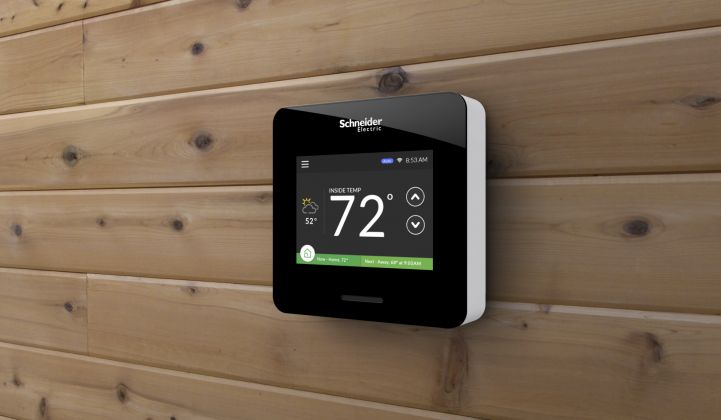More than two years ago, Schneider Electric revamped its Wiser home energy management offering, hoping to appeal to utilities that might be eager for a comprehensive residential demand response offering.
It didn’t go far.
As the portfolio of products hit the (utility) market and a partnership with Alarm.com was formed, Schneider had already realized the approach might not work. The industrial giant would need to pivot to gain any traction with consumers.
“Yes, it took us this much time, but we wanted to do it right,” said Yann Kulp, Schneider Electric’s VP of residential energy solutions. “A consumer’s tolerance for failure is very slim.”
The focus on the consumer, rather than just the utility, is more than just a pivot for the French energy management firm. Instead of retweaking a range of products that included an in-home display and smart plugs, the industrial grid giant chose to focus on the one item consumers care about: the thermostat. The new Wiser Air thermostat is a sleek piece of hardware that hooks up to Wi-Fi. It is also equipped with ZigBee to interface with smart meters or other smart home devices.
Schneider’s previous home energy offering hit the market at a time when utilities were just starting to test the idea of outsourcing residential demand response through bring-your-own-thermostat programs and offering rebates for intelligent thermostats that they would not have to install. Other features of the offering, such as a web portal for customer engagement, were already being offered by other competitors -- and more successfully.
The Wiser Air has many of the bells and whistles of its competitors, including Nest, ecobee and Honeywell, with more coming in 2016. It takes advantage of Schneider Electric’s weather forecasting service, which is used by utilities, airlines and professional sports leagues. The thermostat uses that detailed weather information to provide better energy efficiency and also provides the local weather on the thermostat’s display.
Starting in 2016, the Wiser will also be equipped with an algorithm-based feature called EcoIQ that can discern the patterns of the home and its residents and adjust accordingly. There are some unique features, such as Comfort Boost, where people can turn up the heat or AC quickly for a short period of time and then the system returns to its scheduled temperature.
Kulp said it would have been possible to launch the device earlier this year, but the company wanted a product that was as free of bugs as possible and that would be welcomed in the marketplace, especially given the competition.
Schneider Electric comes from an industrial controls background and not a consumer products history. Knowing its own shortcomings, Schneider beefed up some of its capabilities in-house and also partnered with consulting firm Smart Design, which had worked with brands such as Under Armour, simplehuman and Flip Video.
The utility has taken a backseat to the consumer in terms of design, but Kulp said the thermostat’s backend was designed to make it easy for utilities to get the data they need from the device in order to run residential demand-response programs. Schneider will look at bring-your-own-thermostat programs, as well as rebate opportunities with utilities.
Schneider does not have plans to jump further into the connected-home products space. For now, Kulp said, the focus is solely on Wiser Air. This year was the first year in which smart thermostats made up more than half the market compared to older programmable thermostats. In the future, there could be a role for Schneider Electric in managing a home load when more sophisticated energy controls are needed, such as managing load between the house, an electric vehicle and rooftop solar.
The percentage of thermostats being sold through retail channels instead of through HVAC dealers has also increased considerably in recent years, while the utility channel is stagnant, according to Parks Associates.
“Utilities are no longer in a position to impose on the consumers what’s convenient for them,” said Kulp. “The emphasis had to be on a stellar consumer experience.”



